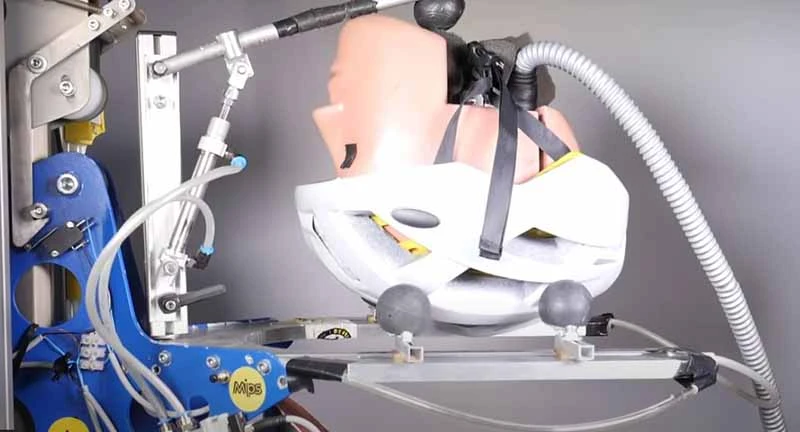Every motorcycle rider and passenger must wear a helmet as a matter of safety. Like a seat belt in a car, a motorcycle helmet protects the rider and must adhere to U.S. Department of Transportation guidelines to be functional. Wearing a motorbike helmet has several advantages.
Helmets for motorcyclists save lives. The U.S. Department of Transportation (DOT) has mandated the Federal Motor Vehicle Safety Standard (FMVSS) 218 for all motorcycle helmets marketed in the nation to safeguard motorcycle riders’ lives. This standard establishes the minimum performance requirements that helmets must achieve to safeguard the head and brain in the case of a collision.
US Motorcycle Helmet Standard: Department of Transportation (Federal Motor Vehicle Safety Standard-218 FMVSS-218)
The legal federal standard for motorcycle helmets used on public highways and other property in the United States is set by the U.S. Department of Transportation. Remember, Helmets are not “approved” by the DOT. Manufacturers of helmets are required by the DOT to get certification that each model sold in the US complies with the DOT standard. The federal standard FMVSS 218 is the current DOT rating.
The FMVSS-218 certification, “DOT certification” is the LEGAL MINIMUM STANDARD that helmets must pass in the United States.
For helmets intended for on-road usage, the National Highway Safety Administration (NHTSA) has enforcement power over the DOT certification requirement, while wearing a certified helmet for off-road activities or competition is definitely a good idea. Before a helmet manufacturer can claim DOT certification, they must test and self-certify the models they want to sell in accordance with DOT regulations. Then they must permanently attach the “DOT” emblem, which denotes conformity with FMVSS 218, to their products.
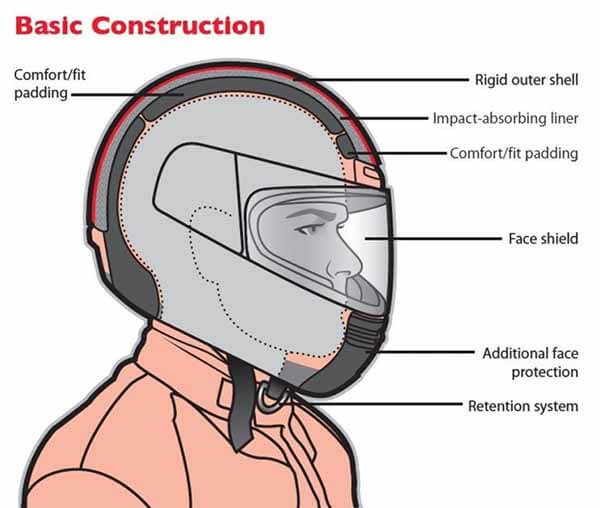
For motorcycle helmets to be sold legally in the US, they must receive at least one safety certification. Importers must get DOT or Snell clearance before importing motorcycle helmets.
The sale of helmets in the US that fails DOT tests is technically illegal. Some manufacturers, however, circumvent this by marketing novelty helmets rather than genuine motorcycle helmets, which are sold as the former. Companies can get away with selling helmets that do not adhere to DOT regulations since the restrictions are so lax.
The DOT standard, which is a mandated requirement, is the most crucial level for helmets to achieve in the United States notwithstanding the regulations’ shortcomings. In the USA, DOT criteria are met by most actual motorcycle helmets. Though less strict than some other testing, the Department of Transportation examinations nevertheless eliminates substandard helmets.
The regular Department of Transportation test is not significantly different from other tests. A helmet must be durable enough to withstand impacts and projectiles, as well as dampness, wetness, heat, and cold. Standards can be more stringent, and testers might subject helmets to additional tests that are optional for DOT certification.
If a manufacturer wants to get DOT certification, the helmet needs to pass through the following four tests:
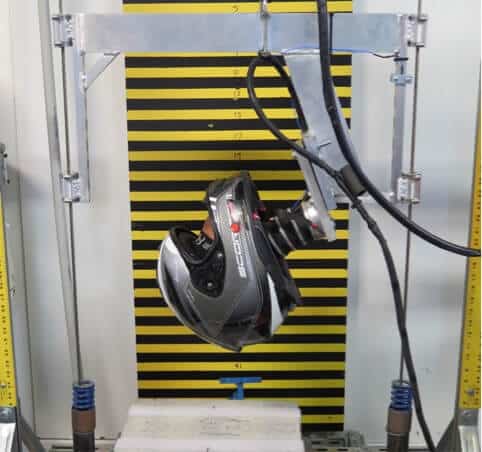
A helmet must pass each of four tests to receive DOT certification. The impact test, the penetration test, the retention strap test, and the peripheral vision test are all requirements for a helmet. The standards are a little more moderate than for certain other motorcycle helmet certificates, even though these tests are difficult to pass.
The helmet is hit against an anvil during the impact test to see how severe of a crash it can withstand. It uses both a flat and a rounded anvil.
In ideal circumstances, the helmet’s capacity to withstand hits and absorb shock is insufficient. The helmet must function in humid conditions, hot or cold temperatures, and when it is wet. To ensure that the helmet will function in all circumstances, safety testing models these unfavorable scenarios.
The penetration test demands precision. In a typical test, a helmet must be able to survive the impact of a six-pound pointed item falling into it from a height of 10 feet, 10 inches. Even when it is hot, chilly, or wet, the helmet must still pass the penetration test.
The strap test is further tested with weights. The helmet fails the retention strap test if the strap does not break but stretches beyond what is permitted. The strap can only lengthen to a certain degree when it is pulled on.
DOT Label After Certification
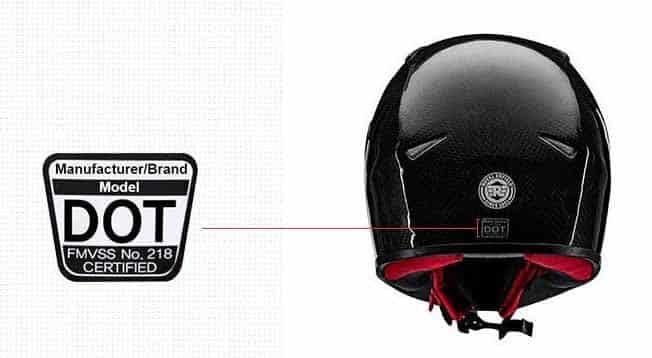
A sticker with the letters “DOT” on the outside back of the helmet is required for helmets that comply with FMVSS 218. The DOT sticker certifies that the helmet complies with or exceeds FMVSS 218. It is crucial to note that some sellers of novelty helmets provide riders with DOT stickers separately to put on helmets that do not comply. The DOT sticker is not legitimate in this situation and does not represent compliance.
The certification sticker must remain to be attached to the helmet even if conformity with the standard has been confirmed. Near the bottom border of the rear portion of the helmet, there must be a “CERTIFIED” label.
The motorcycle helmets must also have a label on them that says the following:
- Name of the manufacturer
- Distinct size
- Month and year that the product was manufactured
A second sticker from the Snell Memorial Foundation can be found on some DOT helmets. If a helmet has a Snell Memorial sticker, it has undergone additional testing and complies with the higher Snell Foundation criteria. The US DOT and European (ECE R22-05) criteria are often met by helmets that pass Snell’s M2010 specifications.
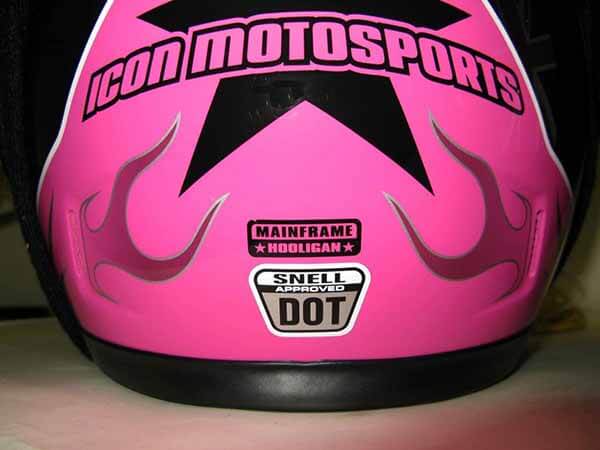
How To Identify A Helmet That Is DOT Certified?
Here is a detail on what to check for DOT certification of a Helmet.
1. A Thich Inner Layer
Helmets that meet the minimum Federal safety standard typically include an inner liner made of hard polystyrene foam that is about an inch thick. Although the inner liner is occasionally invisible. Unsafe helmets typically just have thin foam padding or are made entirely of bare plastic.
2. Helmet Weight
Unsafe helmets can be as light as one pound, depending on their design. Helmets that comply with FMVSS 218 typically weigh three pounds. Learn about the weight of helmets that meet Federal safety requirements. These helmets give off a heavier feeling.
3. Chin Strap and Rivets Are Strong
The chinstraps on helmets that adhere to the DOT safety standard are robust and riveted firmly.
4. Helmet Style and Design
Nothing may protrude farther than two-tenths of an inch from the surface of a helmet in accordance with DOT safety regulations. For instance, while visor fasteners are permitted, a helmet is considered dangerous if it has a spike or other protruding ornamentation. A hazardous helmet may be identified by a design, such as the German Army style or the skullcap style. Helmets that don’t satisfy the DOT standard are visibly thinner and smaller in diameter. Some helmets made for the German Army, though, might comply with federal regulations.
The DOT test is most likely not the final word in determining if your helmet is a good one. But neither is it intended to be; rather, it’s a measure to guarantee that crash helmet sold in the US as rider protection provide a minimal level of protection.
Snell Standard
In the US, the Snell standard is not mandated by legislation, with some racial bodies being an exception. Though it is a harsher standard for motorcycle helmets used in racing activities like drag racing and karting, it has been widely accepted to assess the safety standards of a motorcycle helmet.
The Snell M2015 standard is used for street-legal motorcycle helmets whereas the SA 2015 Snell standard is used for race-legal motorcycle helmets. Depending on the kind of helmet, importers must adhere to appropriate requirements and evaluate conformance prior to import.
The Snell Memorial Foundation has created more stringent specifications and testing methods for motorcycle helmets with racing events like drag racing, motocross, and karting in mind.
However, purchasing a helmet with Snell certification is entirely optional. The DOT criteria still apply; the Snell standards do not.
When evaluating the purchase of a helmet, many motorcycle riders in North America believe that Snell certification offers superior advantages. This is because SNELL rules permit a rider’s head to be subjected to higher g pressures than the DOT requirement.
The chin bar of full-face helmets is tested according to the Snell and ECE 22.05 standards, but not the DOT standard.
ANSI Label or Snell
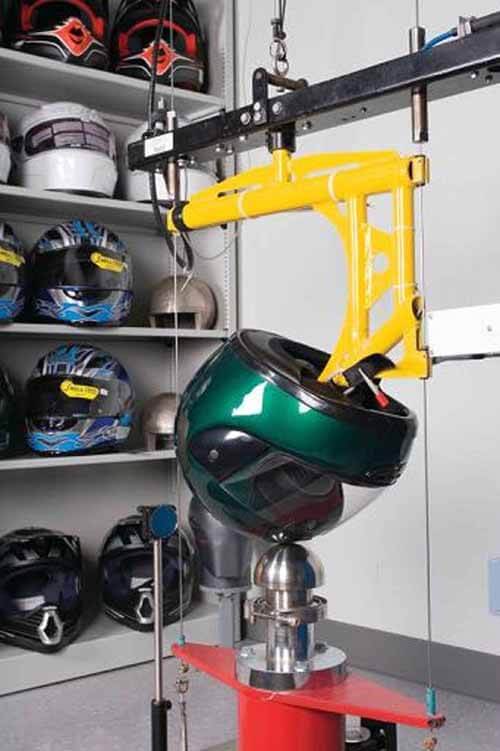
Along with the DOT sticker, labels inside the helmet indicating compliance with private, nonprofit standards set by Snell or the American National Standards Institute (ANSI) are reliable signs that the helmet satisfies federal safety regulations. We have yet to come across a novelty helmet that contains both a fake DOT sticker and a fake Snell or ANSI label.
Snell Memorial Foundation
The organization is named after William “Pete” Snell, a race car driver who passed away in 1956 as a result of severe brain injuries sustained in a racing accident. His friends and acquaintances founded the charitable Snell Memorial Foundation in 1957. (SMF). The foundation’s objectives were to support the creation of safety helmets and to research and comprehend the processes of head injuries in motorsports.

Today, the SMF certifies several types of helmets for use in specified activities by testing them. It now provides guidelines for protective headwear used in competitive skiing, snowboarding, karting, motorcycling, non-motorized sports, and equestrian and harness racing. The Foundation is curious about pretty much any type of headgear used to reduce accident impact injuries. Snell Process for Approval Manufacturers of helmets submits their goods for certification. The manufacturer has the right to use the Snell brand and emblem in advertising and on product packaging. For use on their approved items, the firm also buys certification decals.
The manufacturer must uphold their high standards for all their certified manufacturing in accordance with the terms of their contract with the SMF. An experiment using a random sample is used to verify. As part of this initiative, For the purpose of maintaining the high quality of the product, the SMF buys and inspects helmets. To assess the quality of the helmets provided directly to customers, the SMF goes to great lengths to ensure that these random sample helmets are drawn from the same supply as those sold in stores. Modern testing facilities are kept up by the SMF in the US and England.
Summary of the Snell Standard: Revised every five years. presently accepted 2000. extensive investigation and testing. verification by means of repeated random testing.
What Are Helmets With Snell Approval?
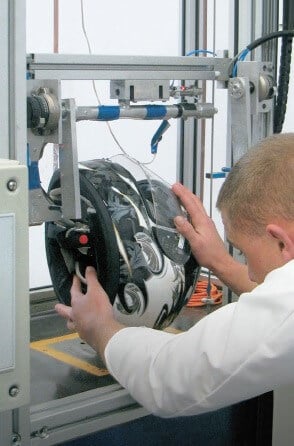
Each governing body has its own certification and acknowledges the Snell certification as one of the top racing helmets available today. You must wear a helmet with a Snell rating of SA2010 or newer if you go to an SCDA event. Clients frequently enquire as to why ratings and certification procedures differ.
Snell Helmet Testing
-
Impact Test
In this experiment, a helmet is mounted on a steelhead form and carefully dropped upon a variety of steel test anvils that reflect different effect surfaces (such as Flat, Hemisphere, Kurbstone, Rollbar, Facet, or a Horseshoe type). The apex forms have an accelerometer connected to measure the peak acceleration, or G force, which is represented by the letter “G” in gravity devices. The impact of electricity (drop peak and mass), or how hard the helmets are struck, varies for each location. However, if the peak acceleration applied to the head shape exceeds a specific level in any acceptable test, the helmet is invalidated (among 260 and 300 Gs, relying on the same old and check type).
-
Test for Positional Stability With Roll-Off
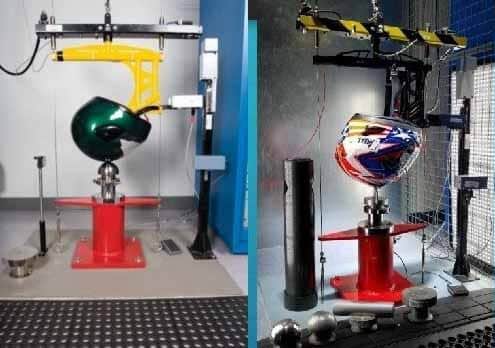
A head shape is mounted on a stand and is inclined 135 degrees toward the ground. A “best fit” is achieved by placing the helmet on the head form and adjusting the straps and buckles. A wire rope is carried forward and fastened to the back edge of the helmet such that its free end crosses the helmet and descends to the ground. A 4 kg weight rests on the mechanical stop that the rope’s free end has on it. A specified height is reached before the weight is hoisted and lowered upon the stop. The helmet experiences a rotational load as a result of the shock. The helmet can be moved, but it can’t fall off.
-
Test of Dynamic Retention
The helmet is put over a head form, and the chin strap is attached over something that roughly resembles the shape of the jaw. A 23 kg weight is applied to the jaw piece for roughly one minute. The retention mechanism is put to the test by abruptly applying a 38 kg mass while concurrently withdrawing a 23 kg weight. If the retention system’s greatest instantaneous deflection (stretch) reaches 30 mm or if it is unable to handle the mechanical loads, the retention system fails. Although the drop heights for the 38 kg typefaces vary according on the standard.
-
Test For Chin Bar Rigidity
The chin bar of the helmet is facing upward, and it is fastened to a sturdy foundation. Through a controlled fall, a 5 kg weight is lowered to impact the chin bar’s middle. The chin bar’s maximum downward deflection must not go beyond the specified distance.
-
Test Of Shell Penetration
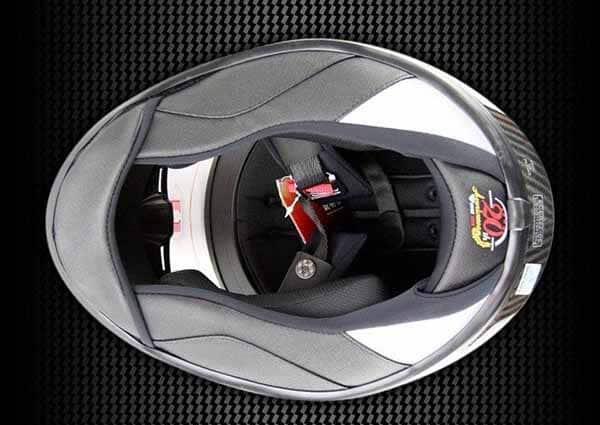
Helmets used in motorcycle, kart, special applications, skiing, and equestrian competitions must pass the shell penetration test. Attached to a sturdy base is the helmet. A 3 kg striker with a sharp point is thrown upon the helmet in a controlled fall from a predetermined height. The striker in the test must not break through the helmet or even make brief contact with the head form.
How Can You Determine a Helmet’s Certification?
You can gauge the density of the helmet by looking inside it. When using a helmet with DOT certification, an inner liner that is roughly 1′′ thick is required. You may gauge how thick the liner is by circling the interior of the helmet with your palm. Helmets are the most crucial piece of safety gear; thus, drivers and riders should wear them. A Snell certification that is accepted by several important organizations serves as the basis for helmet testing. Attendees of SCDA events must wear a helmet with a Snell rating of SA2010 or less.
Motorcycle Helmet Laws By State In The US
Did you know that different states have varying regulations regarding whether you must wear a helmet when riding a bike? Make sure you are aware of the motorcycle helmet legislation in each state you ride through, whether you are moving to a new state or preparing for a cross-country journey.
States That Require Motorcycle Helmets
Most states have laws mandating both the rider and their passenger to wear helmets. In several places, including Arizona, Alaska, Hawaii, Colorado, New Mexico, Indiana, and Utah drivers and passengers who are under the age of 18 are required to wear helmets.
Other states have laws requiring motorcycle helmet use for drivers of all ages. For instance, drivers and passengers must always wear safety helmets in the states of California, Maryland, Nevada, Oregon, New York, Washington, and Oregon regardless of their age.
States Without Helmet Laws For Motorcycles

Only a small number of states, regardless of the rider’s age, do not have any requirements for helmet laws. These unusual states include New Hampshire, Illinois, and Iowa.
To make it simple for you to organize your next ride, we’ve highlighted the most crucial details to be aware of for each state below.
-
Helmet law for motorcycles in Washington, D.C.
All motorcycle drivers and passengers are required by D.C. law to wear helmets that have been approved by the department’s director. The helmet must, at the very least, adhere to Standard Z90-.1-1966 from the American National Standards Institute (ANSI), which indicates defensive headgear for vehicle clients. Get comfortable with the American National Standards Institute (ANSI). As indicated by D.C. regulation, cruiser protective caps should likewise incorporate extremely durable, weatherproof reflectors that cover an area of no less than four crawls on each side. Moreover required is a neck or chin strap on the helmet. The regulation also stipulates that helmets must allow for 120 degrees of unrestricted peripheral vision on either side. Additionally, helmets must allow for unhindered hearing.
-
Alabama Motorcycle Helmet Laws
Anybody working or riding a motorbike in Alabama is legally necessary to wear defensive headgear made explicitly for cruiser administrators and travelers. The protective cap should consent to the law’s necessity for a hearty, effect, and entrance safe outside shell made of nonculturable material. Furthermore, the cap needs to have a safely secured shock-retaining support for the head that is made to hold the cap and keep the head and external shell separated. All segments of the cap’s cushioning where the head is close or may come into contact with the external shell should be influenced safe, retentive, and of a huge thickness. The cap should be developed of durable materials that won’t change observably after some time.
-
Alaska Motorcycle Helmet Laws
While riding a bike, all riders, including those younger than 18, should wear a head protector.
No of their age, riders with student’s licenses are expected to wear caps.
The Public Safety Commissioner of Alaska made and manages the rule. It is ideal to confirm with the Commissioner prior to riding as a driver or traveler on a bike in Alaska on the grounds that these prerequisites and guidelines are liable to change.
-
Arizona’s Law On Motorcycle Helmets
Just cruiser drivers and riders younger than 18 are expected to wear head protectors in Arizona.
Moreover, except if the bicycle has a defensive windshield, all riders, and administrators, paying little mind to mature, should wear wellbeing glasses, goggles, or an unmistakable face safeguard.
-
Motorbike Helmet Law In Arkansas
By law, anyone riding a motorcycle under the age of 21 must wear a helmet. When utilized by municipal police departments, three-wheel bikes with cabs and windshields and horsepower ratings under twenty (20 hp) are exempt from the helmet requirement. However, regardless of age, all must wear safety goggles, face shields, or protective glasses.
-
California Motorcycle Helmet Law
Anybody working an engine vehicle or riding a motorbike in California is expected to wear a well-being head protector that follows government and state security guidelines. It should fit cozily without an excessive amount of parallel or vertical development and be affixed with the cap lashes.
The main exception to this guideline is the point at which an individual is driving or riding in a completely encased, three-wheeled auto that is seven feet in length, four feet wide, or more noteworthy, and weighs no less than 900 pounds without travelers.
It is critical to check with the Commissioner of Motor Vehicles or a comparable division prior to riding a cruiser on Californian streets on the grounds that these guidelines are likely to change.
-
Colorado Motorcycle Helmet Law
Grown-up cruiser riders and travelers are not expected to wear caps in Colorado. The United States Department of Transportation (DOT) has set rules for cruiser protective caps, and they should be worn by all drivers and travelers who are younger than 18. The protective caps should be made to restrict injury from head contact and should have a coating, cushioning, and a jawline tie. Any second the cruiser is moving; the chip lash should be on.
Grown-up drivers and travelers should wear goggles or glasses with security glass or plastic focal points. If the driver or traveler is wearing a cap with wellbeing glass or plastic eye security, these eye insurance gadgets are excessive.
Adopting guidelines and requirements for the creation of sunglasses and eyewear is the responsibility of the Colorado Department of Revenue.
-
Law On Motorcycle Helmets In Connecticut
In Connecticut, it is illegal for anybody under the age of 18 to drive or ride a motorcycle without a helmet. Getting a ticket for not wearing a helmet carries a $90 punishment. Adoption of helmet laws is the responsibility of the Commissioner of Motor Vehicles. Cruiser drivers and travelers ought to check with the Commissioner prior to riding on Connecticut streets because these principles are dependent on future developments.
-
Delaware’s Motorcycle Helmet Law
Delaware’s motorcycle helmet law mandates that all riders under the age of 19 wear authorized eye protection and a safety helmet. Any cyclist who is older than 19 years old must always wear eye protection and a helmet.
-
Motorcycle Helmet Law in Florida
The helmet law in Florida is a little complicated. In general, helmet use is mandated for all motorcycle drivers and riders. However, operators and riders over the age of 21 are exempt from the helmet rule if they are insured by an insurance plan that pays at least $10,000 in medical benefits for injuries sustained in a motorcycle crash.
Most states have laws mandating both the rider and their passenger to wear helmets. In several places, including Alaska, Arizona, Colorado, Hawaii, Indiana, New Mexico, Utah, and Maine, drivers, and passengers who are under the age of 18 are required to wear helmets.
-
Motorcycle Helmet Law in Georgia
All cruiser drivers and riders are legally necessary to wear protective caps. On the off chance that there is no windshield on the bike, eye insurance is likewise fundamental. The prerequisites for caps and eye insurance are set by the Commissioner of Motor Vehicle Safety. Prior to riding a cruiser in Georgia, you ought to check with the Commissioner because these guidelines are dependent on future developments.
-
Hawaii’s Law on Motorcycle Helmets
In Hawaii, except if they are wearing a well-being head protector that is immovably associated with a jawline lash, nobody younger than 18 is permitted to work a cruiser or ride as a traveler. Beyond 18 years old, riders are not expected to wear a cap, however, they are expected to wear security glasses, goggles, or a face safeguard on the off chance that the cruiser doesn’t have a windshield.
Before hitting the road, check with the Director to make sure you’re in compliance with Hawaii law.
-
Motorcycle Helmet Law in Idaho
Anybody younger than 18 who works a motorbike or rides one should wear a head protector that meets or surpasses the rules set by the Director of Motor Vehicles for caps. While riding or working a motorbike on the confidential property or while involving it as an instrument for cultivation, the cap regulation doesn’t have any significant bearing. Prior to riding a motorbike in Idaho, it is ideal to check with the Director to ensure your cap consents to these prerequisites.
-
Motorcycle Helmet Law in Illinois
Helmet use is not mandated by Illinois law for riders or passengers. However, the legislation does mandate that both drivers and passengers wear eye protection, such as glasses, goggles, or a clear shield. The term “glasses” as used in Illinois law refers to common eyewear worn in front of the eye, such as eyeglasses or sunglasses constructed of shatter-resistant material. A piece of eye protection that doesn’t restrict peripheral vision is referred to as “goggles.” The front and sides of the goggles must be protected, and they may or may not completely seal against the face.
-
Indiana’s Law on Motorcycle Helmets
Only motorcycle riders and drivers under the age of 18 are required by Indiana law to wear a helmet and safety goggles, glasses, or face shields.
-
Motorcycle Helmet Law in Iowa
There is no helmet requirement in Iowa. In 1976, the Iowa legislature removed the need for wearing a helmet. As of 2013, legislation to reinstitute Iowa’s required helmet law is being suggested.
-
Kansas’s Law on Motorcycle Helmets
Anyone under the age of 18 who rides a motorcycle is required to wear a helmet. After turning 18, bikers are no longer required to wear helmets because the state eliminated its mandatory helmet regulation in 1976.
-
Motorcycle Helmet Law in Kentucky
According to Kentucky law, anyone under the age of 21 who drives, rides, or is in a sidecar that is attached must wear a helmet.
Helmets are also required for drivers who have motorcycle instruction permits or licenses that have been in effect for less than a year. Passengers are not permitted in vehicles driven by people with permits.
No matter their age, all motorcycle drivers must use certified eye protection, according to the cabinet of the Secretary of Transportation.
-
Louisiana’s Law on Motorcycle Helmets
Anyone operating or riding a motorbike in Louisiana is expected to constantly wear a head protector with a jaw tie secured on while the bike is moving. While such individuals are partaking in a procession or other public show, police specialists of a town, town, city, or ward might give a grant excluding individuals from associations supporting, leading, or taking part in marches or other public displays from the head protector necessity. An individual working or riding in an auto-cycle is excluded from the protective cap necessity on the off chance that the vehicle is fitted with a rooftop that follows or surpasses wellbeing cap guidelines.
-
Motorcycle Helmet Law in Maine
All sidecar and motorcycle passengers younger than 18 are expected by Maine regulation to wear head protectors. Protective caps are likewise expected for cruiser drivers who got their licenses in the span of time of finishing their driver’s assessment and for those with student grants.
According to Maine law, a passenger must also wear a helmet when the operator is obligated to do so. Protective headgear must adhere to the Federal Motor Vehicle Safety Standard or the American National Standards Institute’s basic requirements.
-
Maryland’s Law on Motorcycle Helmets
In Maryland, a helmet is a requirement for both riders and drivers. In addition, unless the motorcycle has a windscreen, all riders must wear eye protection.
The Maryland Administrator of Transportation, who approves wellbeing gear and takes on/upholds rules and details for endorsement of security gear, has set guidelines for head protectors and eye assurance that should be fulfilled. A rundown of all defensive hardware that has been approved by name and type is unveiled by the Administrator.
-
Massachusetts’s Helmet Requirement Law
According to Massachusetts law, all motorcyclists must wear helmets that meet the minimum requirements established by the Registrar of Motor Vehicles. Anyone riding in a sidecar must comply with the mandatory helmet law as well. If the motorcycle lacks a windshield or screen, the rider must also wear eyeglasses, goggles, or a protective face shield.
-
Motorcycle Helmet Law in Michigan
Riders in Michigan are expected to wear caps until they turn 21. Riders beyond 21 years old are excluded from wearing head protectors on the off chance that they meet the accompanying measures: A.) They have held a cruiser underwriting on their administrator’s permit for no less than two years, B.) They have set up security for the first-party health advantages payable in case of a mishap (for a bike administrator without a rider, $20,000 or more; for a bike administrator with a rider, $5,000 or more). The administrator is possibly expected to assume the rider has the security of $20,000 or more.
-
Minnesota’s Helmet Law for Motorcycles
All bike drivers and riders younger than 18 are expected by Minnesota regulation to wear caps. Furthermore, paying little mind to maturity, anybody working a bike while holding a student’s permit is expected to wear a head protector.
Both carrying passengers and using the interstate at night are prohibited for drivers with learner’s permits.
In accordance with Minnesota law, eye protection is a must for all motorcycle drivers, regardless of age. The Minnesota Commissioner of Public Safety has set criteria for all helmets and eye protective equipment.
-
Law on Motorcycle Helmets in Mississippi
According to Mississippi law, all bike drivers and riders should wear caps that have passed the American Association of Motor Vehicle Administrators’ review and endorsement.
Figure out additional about the principles set by the American Association of Motor Vehicle Administrators.
-
Motorcycle Helmet Law in Missouri
For drivers and passengers who are 26 years of age or older and have health insurance, wearing a helmet is optional.
Regardless of age, everyone operating a motorcycle with a learner’s license must wear a helmet.
-
Nebraska’s Motorcycle Helmet
the law stipulates that whenever a motorbike is moving, both the rider and any passengers must always wear a helmet with a chin strap fastened. Nebraska law stipulates that the helmet must include a chin strap as well as liner and padding that satisfies or exceeds federal standards.
-
Motorcycle Helmet Law in New Jersey
All cruiser drivers and travelers in New Jersey are expected to wear an appropriately estimated, safely fitted protective cap that is supported by the state’s overseer of engine vehicles. Both sides of the helmet must be “reflectorized,” and it must include a neck or chin strap. All motorcycle operators must also wear protective eyewear.
-
Motorcycle Helmet Law in New Mexico
The Director of Transportation of New Mexico has established criteria for helmets that must be worn by those who are subject to the legislation. Before hitting the road in New Mexico, you should check with the Director because these requirements are subject to modification.
-
New York’s Helmet Law For Motorcycles
All motorcycle drivers and riders must adhere to New York law and wear approved helmets.
Police departments in cities, municipalities, and villages have the authority to issue licenses that exclude participants from wearing helmets during parades or other public displays. All cruiser drivers should likewise wear eye security or a face safeguard that has been supported by the magistrate of the branch of engine vehicles in New York. The Commissioner might embrace and amend rules overseeing the assortments of adequate goggles and face safeguards and their prerequisites. Counsel the Department of Motor Vehicles to affirm that your eye security follows the Commissioner’s necessities.
-
Law on Motorcycle Helmets in North Carolina
All cruiser drivers and travelers in North Carolina are expected to wear protective caps that have been approved by the US Department of Transportation (DOT), with the jawline lashes secured. Prior to riding a bike in North Carolina, check sure the Commissioner has approved your protective cap.
-
Motorcycle Helmet Law in Ohio
All motorcycle riders under the age of 18 and those with a “novice license” are required to wear helmets in Ohio. Motorcycle drivers in Ohio who are 18 years of age or older and who have never held a motorcycle license issued by Ohio, another state, or a jurisdiction recognized by Ohio law are issued “novice licenses”. Additionally, regardless of age, riders with “novice” licenses are required to wear helmets, as are any motorcycle passengers under the age of 18. All drivers and passengers must always wear safety goggles or other protective equipment.
-
Motorcycle Helmet Law in Oklahoma
According to Oklahoma law, only riders and passengers who are under the age of 18 are required to wear caps. The headgear should have cushioning, covering, and jawline lashes, and it can’t discourage the driver’s vision.
In any case, except if the bicycle has a windshield of sufficient quality, size, and thickness to safeguard the administrator from unfamiliar things, administrators, everything being equal, should wear goggles or a face safeguard of material and plan that shields the driver from unfamiliar items.
The Commissioner of the Department of Public Safety manages the helmet regulations in Oklahoma. Before riding a motorbike in Oklahoma, whether as a driver or passenger, it is essential to verify with the Commissioner because rules are subject to change.
-
Law on Motorcycle Helmets in Pennsylvania
In 2003, Pennsylvania’s helmet-requirement statute was abolished. Helmets are not needed for motorcyclists who are 21 years old or more established, who have held a bike permit for no less than two years, or who have completed a cruiser rider security course approved by the Department of Motor Vehicles or the Motorcycle Safety Foundation. On the off chance that the rider of the cruiser isn’t lawfully constrained to wear a cap, travelers who are 21 years old or more seasoned are permitted to ride without head protectors. Protective caps are obligatory for cruiser riders with student grants.
-
Law on Motorcycle Helmets in South Carolina
All bike drivers and travelers younger than 21 in South Carolina are expected to wear a protective cap that has been approved by the Department of Highways and Public Transportation. The two sides of the head protector should be “reflectorized,” and it should incorporate a neck or jaw tie.
The Department is engaged to lay out and keep a rundown of endorsed protective caps as well as to propose and revise rules overseeing head protector types and particulars. Prior to riding a bike in South Carolina, it is prudent to affirm the latest guidelines with the Department on the off chance that you are dependent upon the cap regulation.
-
South Dakota’s Helmet Requirement Law
All motorcycle drivers and passengers under the age of 18 are required by South Dakota law to wear a federally compliant helmet. Additionally, unless their motorcycle has a windshield with enough height, drivers of motorcycles are required by law to wear eye protection. Additionally, according to South Dakota law, passengers in an enclosed cab are not required to wear a helmet or eye protection.
A passenger under the age of 18 cannot be operated on a motorcycle unless they are secured in a helmet.
-
Texas’s Helmet Requirement Law
In general, Texas regulation orders that all drivers and travelers wear protective caps that comply with the state’s Department of Public Safety’s wellbeing guidelines. The exemptions for this standard are anybody beyond 21 years old who effectively completed an endorsed cruiser administrator preparing and wellbeing course or the people who have health care coverage that covers something like $10,000 in clinical costs for mishaps while working a bike. An individual working or riding a motorbike may not be halted or kept by a harmony official for the sole reason for affirming whether the individual has effectively finished the bike administrator preparation and security course or is safeguarded by medical coverage.
-
Motorcycle Helmet Law in Virginia
All bike drivers and travelers in Virginia are expected to wear protective caps that stick to or surpass the well-being principles set by the Federal Department of Transportation, the Snell Memorial Foundation, or both. Except if the cruiser has wellbeing glass or a windshield that has been endorsed by the Superintendent of the Department of Motor Vehicles or that satisfies or surpasses the guidelines and particulars of Snell, ANSI, or the government Department of Transportation, Virginia likewise commands that all bike administrators wear a face safeguard, security glasses, or goggles.
-
Washington’s Helmet Law For Motorcycles
Every motorcycle driver and passenger in Washington is required by law to wear a helmet that complies with the standards set by the Washington State Patrol. Either a neck or chin strap is required on the helmet, and both must be tightened firmly when the motorbike is moving. This law is exempt if the vehicle is a vintage motorbike or automobile with a motorcycle license, or if it has seat belts and roll bars that have been approved by the state patrol.
Except if the motorbike has a windshield, all administrators should wear eye security, like glasses, goggles, or a face safeguard, that consents to State Patrol guidelines. The State Patrol has the power and ability to lay out principles and cycles for following regulations and administering the utilization of head protectors, glasses, goggles, and face safeguards. It is essential to check with the State Patrol prior to riding a bike in Washington in light of the fact that these guidelines are dependent upon future developments.
M/Z













